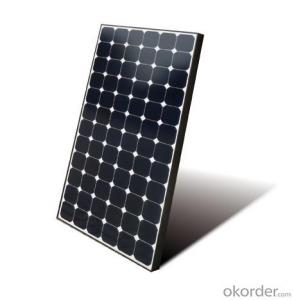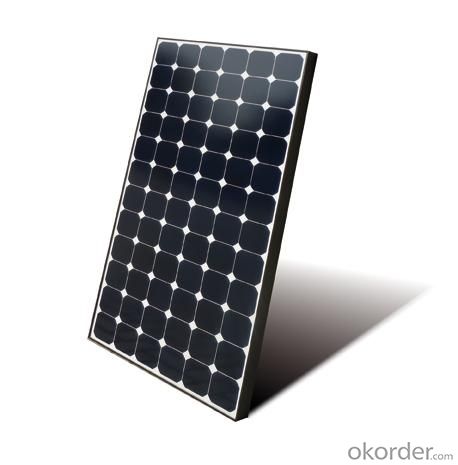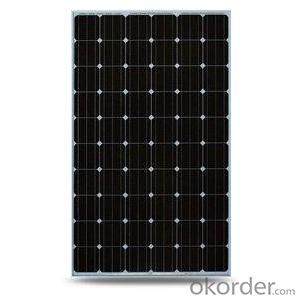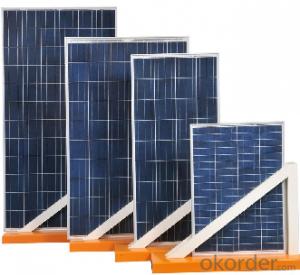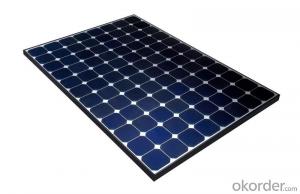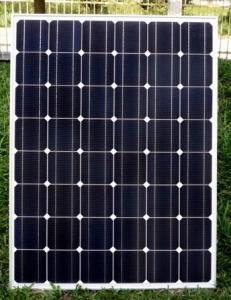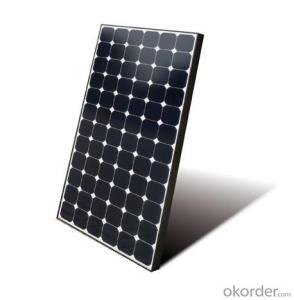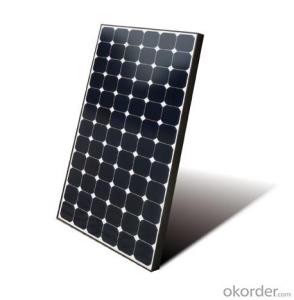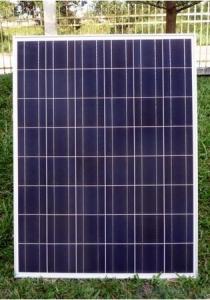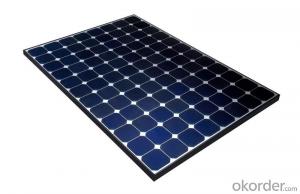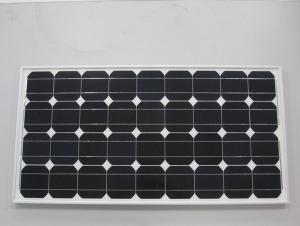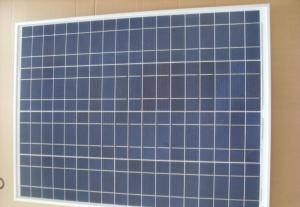Wet Solar Panels - CNBM Poly 180W Solar Panel with TUV UL CE Certificate for Residential
- Loading Port:
- Shanghai
- Payment Terms:
- TT OR LC
- Min Order Qty:
- 100 watt
- Supply Capability:
- 1000 watt/month
OKorder Service Pledge
OKorder Financial Service
You Might Also Like
Specification
CNBM Poly 180W Solar Panel with TUV UL CE Certificate For Residential
Introduction
Each module is rated by its DC output power under standard test conditions, and typically ranges from 100 to 365 watts. The efficiency of a module determines the area of a module given the same rated output – an 8% efficient 230 watt module will have twice the area of a 16% efficient 230 watt module. There are a few solar panels available that are exceeding 19% efficiency. A single solar module can produce only a limited amount of power; most installations contain multiple modules. A photovoltaic system typically includes a panel or an array of solar modules, a solar inverter, and sometimes a battery and/or solar tracker and interconnection wiring.
Solar modules use light energy (photons) from the sun to generate electricity through the photovoltaic effect. The majority of modules use wafer-based crystalline silicon cells or thin-film cells based on cadmium telluride or silicon. The structural (load carrying) member of a module can either be the top layer or the back layer. Cells must also be protected from mechanical damage and moisture. Most solar modules are rigid, but semi-flexible ones are available, based on thin-film cells.
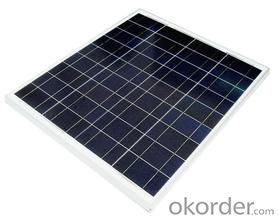
Suggested application
Home lighting business lighting,
Garden lighting, pavement lighting
Farmer household lighting
Decorative water pump
Traffic signal lighting
Industry area
Business area
Solar Power Plant
Product feature
Modules are made of Monocrystalline or Polycrystalline Silicon cell.
Materials and color of the solar panel frame: Clear anodized aluminum alloy type 6063T5 Universal frame; Silver-white color;
The output connection gathers the coupling: Selects conforms to the IEC-612615; 2005, class II, IEC61730 international standard; Airtight waterproofing binding clamp;
Module seal structure: The surface is thick, the high diaphanous rate armored glass with solar cell board special-purpose 3.2mm becomes after the high temperature lamination craft. The back selects has waterproof and anti- aged performance fine TPT materials. The entire block battery board has, the waterproofing, the anti- aging airtight and so on the fine performance;
Power tolerance: +/-3%
Packaging
International standard cartons (according to the requirements of customers)
- Q: I want to install a solar panel on my car. I want to know that how much energy can be generated by a panel of size 4 foot by 6 foot. and the cost of installation.
- A little more than 0 watts per square foot, so that size panel would generate 250 watts under ideal conditions, which is noon on a sunny but not too hot day, near the equator. That's about /3 horsepower, or the same power as a man working hard. That is larger than needed to keep the battery of the car charged, unless you plan to run a laptop or something off it at night. The power is also too small to power the car for driving. If it's an electric car, you could get maybe another 2 miles per day out of the car, again, under ideal conditions. An RV store might have an idea of how much installation would cost. They would be accustomed to solar panels for RV's, but probably not small cars. A panel of that size would cost perhaps $500-800 just for the panel.
- Q: I had installed over the summer a solar panel system on my house. Hers some infofor you: I live in MOThe system cost 25K (Rounded numbers)The Rebate from the utility company was about 0KThe expected tax rebate will be about 5KI have a home office from which I work and is 5% of my homes sq footage. My question is though I am getting a basic tax rebate, should I be able to claim part of this off as an expense for my home office?It seams logical since I used to deduct part of my electric bill and I there for should be able to write off part of this. I am, after all using electricity and getting a bill from the utility that is higher than it would be if I didn't have the office2. If so which amount should it be? The full 25K or something after the rebates.
- You would have to depreciate the office portion over a very long time frame in years. Contact a qualified tax professional as home office deductions set off all sorts of red flags.
- Q: i dont wanna buy a solar panel becuase its too exspensive, i dont want use technical stuff i want to use every day materiels, but i need to know asap plzzzz.
- I'm afraid you can't just make a solar panel with things just laying around the house. They require some specialized materials and techniques to create. Just buy what you need.
- Q: I am fairly new to the solar panel scene, and am eager to try to set one up myself instead of buying a kit. I am looking for a solar panel that puts out 00 Watts or more, and can produce more than 20 volts. Thanks
- Build okorder /
- Q: I'm looking to see how much it would be to install solar panels on a home. Or more information on where i would be able to locate a place of purchase, or in general more information...
- A Solar panel usually cost between $0,000-20,000 and more. If you're not wanting to spend that much, I suggest you try the DIY solar panel guides. These are step-by-step guides in building solar panels. They are very cheap and overall, you can get solar panels for less than $200. The guide will help you choose where to buy and what to buy so you won't spend thousands of dollars. Whether you're a beginner or an expert, you can do it. If you're interested, just click on the link below. I also added some links where you can read reviews about these guides. Goodluck!
- Q: what do solar panels do?
- The cost of electricity is increasing at a rate of 5 to 0 percent every year with no end in sight. A solar panel system captures the (free!) sun and turns it into usable electricity for your home.
- Q: i really love the idea of solar and want to start out small, so i'm new to this.I plan on getting an 85w panel to charge my laptop. what other equipment is needed to accomplish this?would i need to get a battery or does the solar panel hook directly to the laptop. Does one end just lead to a conventional outlet similar to a wall outlet?could someone please give me a detailed explanation with options about this? i would greatly appreciate it.
- humm..... .need HUGE solar panel (alot) 2. wires 3. aligato clips . put the panels on the roof 2. use the aligator clip to clip the wire from the panel to the bars of the pluger of the comp. charger 3.tada mark me best:)
- Q: Can solar panels be used for charging electric vehicles?
- Yes, solar panels can be used to charge electric vehicles.
- Q: How do solar panels withstand hail and other extreme weather conditions?
- Solar panels are designed to withstand hail and extreme weather conditions through their durable construction and protective measures. They are built with tempered glass that can resist impact and damage from hail. Additionally, solar panels undergo rigorous testing to ensure they can withstand high winds, heavy snow loads, and extreme temperatures. The frames and mounting systems are also engineered to provide stability and withstand harsh weather conditions.
- Q: How many solar panels do you need on your house to power your heater in winter?
- Your house, and probably your yard wouldn't be big enough to hold them. I did this exercise once (not doing it again) for someone who wanted to replace his 6hp outboard motor with a solar powered one. The calculations ended up that he would need something like .5 acres of solar panels to get that much energy. Not happening. That said, an passive solar home, can get a significant amount of warmth from the sun directly. But it doesn't work very well at night, when it's coldest. (wonder why that is... probably a climate scientist could help us with that? -- oh, wait. They say warming doesn't have anything to do with the sun.) Edit. I didn't use theoretical stuff to come up with my numbers, I used the claims of actual off-the-shelf solar panels sold by West Marine, calculated the power, and did the math based on existing panels.
Send your message to us
Wet Solar Panels - CNBM Poly 180W Solar Panel with TUV UL CE Certificate for Residential
- Loading Port:
- Shanghai
- Payment Terms:
- TT OR LC
- Min Order Qty:
- 100 watt
- Supply Capability:
- 1000 watt/month
OKorder Service Pledge
OKorder Financial Service
Similar products
Hot products
Hot Searches
Related keywords
